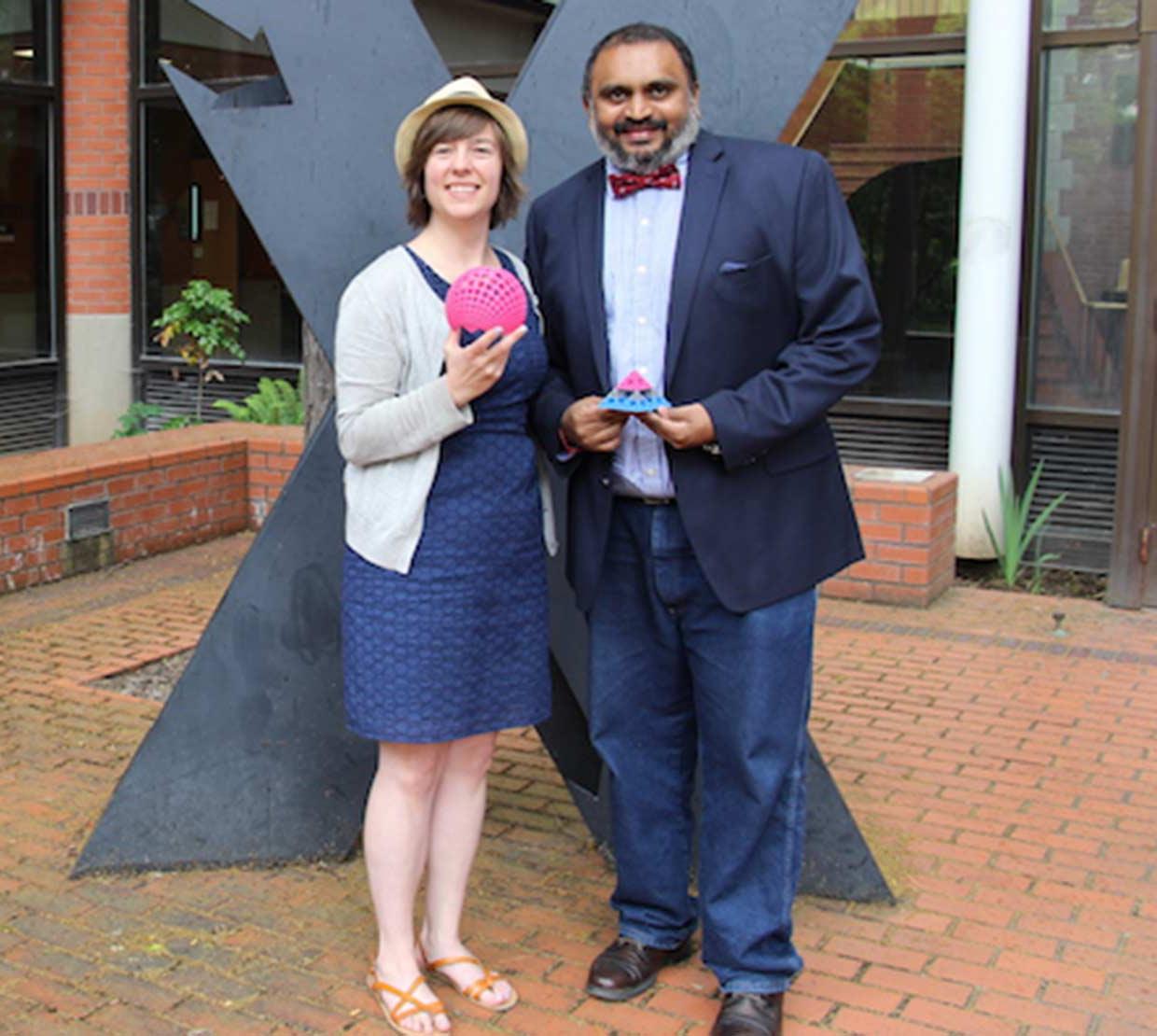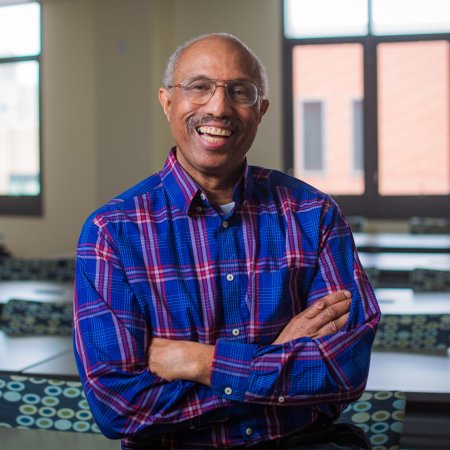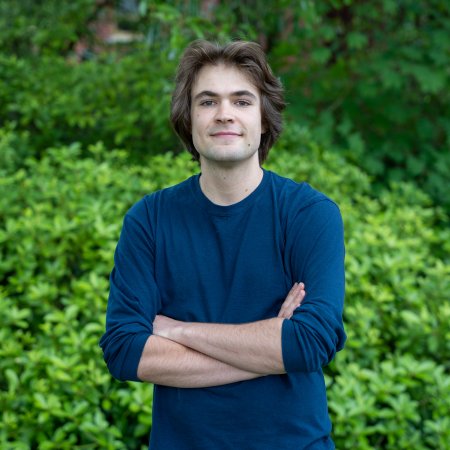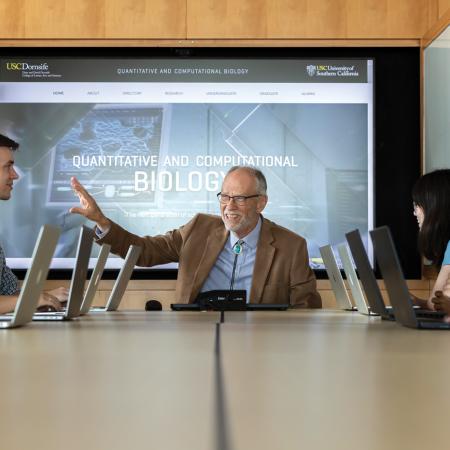New alumnus Naveen Somasunderam (Ph.D. ’19) and Ph.D. student Sarah Hagen recently received top mathematics department awards. Somasunderam received the overall Graduate Student Excellence Award, and Hagen is the William F. Burger Graduate Teaching Award recipient. Somasunderam finished his Ph.D. dissertation research in number theory this spring and will be a tenure track assistant professor at the State University of New York at Plattsburgh in the fall. Hagen’s ongoing Ph.D. dissertation research is in partial differential equations. Both have also shown enormous individual leadership in adapting active learning methods to their teaching, as well as initiating mathematics outreach activities.
Leading from below to promote active learning
Somasunderam created an active learning classroom in teaching calculus, and Hagen designed a week-long boot camp for incoming graduate students as well as a Ph.D. qualifying exam preparatory course. They each created classrooms in which students are provided opportunities to engage in mathematical investigation, communication and group problem-solving, while also receiving feedback on their work from both experts and peers. These classrooms feature practices that engage students in activities, such as reading, writing, discussion, or problem solving, that promote higher-order thinking. There is now clear scientific evidence that these active learning features result in better student performance and retention than more traditional, passive forms of instruction alone.
“I have had many classes where students were so engrossed in the learning that they lost track of time, and not a single student left until I requested them to do so. It is such a rewarding experience as an instructor to see my students enthusiastically take charge of their own learning.”
Both Hagen and Somasunderam adapted a particular tripartite approach for their pedagogy: Students read, then engage and pose written questions before class, and also prepare before-class problem work that is built upon in groups and as a whole class, guided by the instructor. Finally, further higher level homework is completed after class.
“I have had many classes where students were so engrossed in the learning that they lost track of time, and not a single student left until I requested them to do so. It is such a rewarding experience as an instructor to see my students enthusiastically take charge of their own learning,” said Somasunderam.
Hagen describes the active learning process in her classroom. “Students were much more engaged when their classmates presented on the board than when I presented on the board. The few times that I wrote on the board I could feel the room tense up and the students’ eyes glaze over (and I pride myself on being an engaging instructor!). The problem is that they felt like what I had to say was gospel, and so they didn’t engage as much or question as much.
Students often came up with solutions very different than what I had in mind. When there were multiple solutions to the same problem I had students write them all up. We then looked them over, compared them, and discussed the virtues and drawbacks of each attempt. This would *never* have happened if I had simply written my own proof on the board. Teaching with active learning was way more fun than I had anticipated. The fun was being able to interact with the students on a more personal level. Students also gain experience and confidence presenting their work.”
Hagen and Somasunderam are superb examples of “leading from below”, in which graduate students, postdocs, and young faculty are often leading the way toward adoption of evidence-based active learning teaching practices for increasing student engagement and success.
Engaging in mathematics outreach
Both Somasunderam and Hagen have also led in creating outreach from the OSU Mathematics Department. Somasunderam co-created the Math Circus Project, aiming to bring out the artistic and aesthetic aspects of mathematics, by enabling children to play with 3-D printed mathematical objects. One example is an activity with stereographic projection spheres, which children use to investigate transformations of the plane and sphere, as well as to think about notions of infinity. Another theme is hands-on work with fractals. Math Circus events have included College of Science K-12 Discovery Days, Boys and Girls Club of Salem, Franklin School Science Night, and Periwinkle Science Night, Albany. The design and implementation of the Math Circus also includes OSU undergraduates.
Hagen likes to jokingly refer to herself as an “evangelical mathematician.” Intent on spreading the good news about mathematics, she engages in a wide variety of community outreach. Her outreach has targeted preschoolers, retirees and everyone in between. She has participated in outreach events far beyond OSU’s campus. She’s given talks in bookstores, pubs, science festivals and the public library, where her standing room only hands-on events have included topics such as Pi Without Circles, How Big is Infinity? and Ancient Greek Astronomy.
Her talks have been featured in the Corvallis Gazette-Times. She has run math demo booths and workshops at events aimed at children and adults, including an event with logic and probability puzzles for inmates at the Coffee Creek Correctional Facility, organized by and co-designed with fellow graduate student Branwen Purdy. For College of Science K-12 Discovery Days, she developed and recruited volunteers to help run Tic-Tac-Totally Crazy (an activity where participants play variations of tic-tac-toe but with different sized boards). For Mathematical Marvels Day at the Eugene Science Center she developed and ran a demo on the mathematics of fluid dynamics called Order and Chaos in Fluid Flow.
Hagen also performs her unique brand of math-themed comedy throughout the Pacific Northwest (including at the Majestic Theatre in Corvallis), and she co-produced a math-themed comedy benefit for the Eugene Science Center. In an effort to make the department’s outreach efforts more impactful and sustainable, Hagen helped form a mathematics outreach working group and is currently developing an outreach website for the department. She is also a founding member of the Graduate Student Outreach Council in the College of Science, and a current Oregon Museum of Science and Industry Communication Fellow.
Somasunderam and Hagen were together part of a team that developed and ran a Pi Throwing Contest at Da Vinci Days, where participants approximated π using Buffon’s needle experiment (dropping and counting toothpicks instead of needles for safety). Some visitors said it was the most interesting event at the entire fair.
Hagen’s research is in the analysis of the incompressible Navier-Stokes equations. Using the tools of Fourier analysis, complex analysis, dynamical systems, and number theory, she is working to develop theorems regarding the properties and dynamics of solutions that model fluid flow. For instance, a ghost solution is a non-stationary solution whose energy and enstrophy are nevertheless constant in time. She can prove that such ghost solutions exist only outside the (weak) global attractor. She is currently writing a paper to submit for publication. Her research advisor is Radu Dascaliuc.
Somasunderam’s research is in the area of p-adic Fourier analysis and equidistribution. Classical Fourier analysis, which can be described as the study of broad classes of functions using the theory of waves, is a centuries-old research area of deep historical importance to both pure mathematics as well as physics and engineering. His work applies similar principles to the study of objects of interest in number theory, which is the study of the divisibility properties of whole numbers. His results give a way to quantify how well-distributed general sequences are with respect to a certain type of geometry arising naturally from notions of divisibility by prime numbers.
This project required Somasunderam to develop mastery in both analysis and number theory, and his work contains elements of topology and dynamical systems as well. Some of his dissertation work has been submitted for publication in a leading journal on number theory. His research advisor is Clay Petsche.
“It was such an exhilarating experience to see the math that I first saw in high school physics, like taking the Fourier series of a function, having analogues in more advanced research level mathematics. I was awestruck now as much as I was then as a young high school student,” said Somasunderam
The recent awards to Somasunderam and Hagen reflect their extraordinary combination of teaching innovation, outreach, and research.




